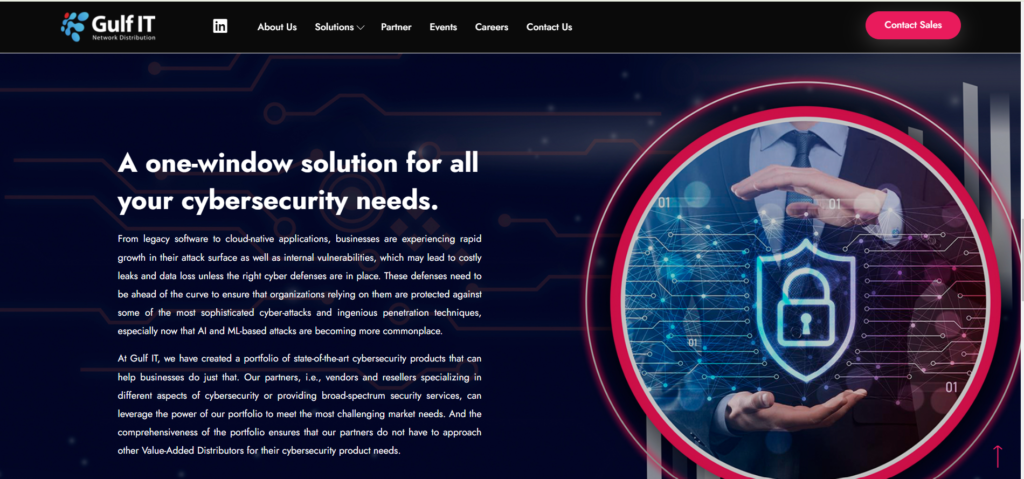30 Handy Tips For Deciding On A Cybersecurity Company in Dubai
30 Handy Tips For Deciding On A Cybersecurity Company in Dubai
Blog Article
Top 10 Tips To Evaluate The Experience And Qualifications Of A Cybersecurity Services Company Located In Dubai, Uae
1. Check out the credentials that the staff members of the business hold. There are certifications available such as Certified Information System Security Professionals (copyright), Certified Information Security Managers (CISM), Certified Ethical Hackers (CEH) and copyright Auditors (CISA). These certifications indicate an adherence to professionalism and the highest levels of knowledge.
Review Team Experience
Ask about the background of the team. For their background inquire about the amount of experience they've had in the field as well as any previous roles. A diverse group of experts who have experience in different fields will help you find fresh ideas and solutions.
3. Check your education background
Check the education level of the most important employees. Degrees in relevant fields like information technology or computer science cybersecurity can indicate an extensive understanding of the subject. Credibility is increased when higher education credentials are paired with professional certificates.
4. Study of the specialization areas
Find any areas of specialization for the team members. Your company's needs might require experts in certain areas, such as cloud security. The expertise of a specialist can provide more effective solutions for specific cybersecurity challenges.
5. Inquire About Ongoing Training and Development
The company should be evaluated on its commitment to continuous training and professional growth. Continuous education is important to stay current with the latest developments in the rapidly-evolving area of cybersecurity. This can be accomplished through seminars, workshops and other certificates.
Review Past Projects or Case Studies
Ask about the company's previous work or case studies. If they are able to describe in detail how they handled specific cybersecurity issues for previous clients, this will provide you with a better understanding of their skills in solving problems.
7. Find Client Testimonials and Referrals
Request testimonials or references from customers who have used the service previously. They will be able to confirm your expertise and performance. Positive feedback is a sign of a solid reputation within the business, and show that the company is able to offer top-quality services.
8. Investigate the possibility of engaging with industry
Find out how the company is involved in the cybersecurity community. If you are a part of conferences, webinars or contribute to cybersecurity-related publications, it could be an indication that the business is dedicated to staying current with developments and best practices.
9. Examine Research and Development Activities
If a company invests in R&D this can improve the cybersecurity offerings of their clients. Companies that focus on R&D are often ahead of the curve in new technologies and solutions, which can benefit clients seeking innovative ways to tackle cybersecurity.
10. You can find awards and recognitions
Examine any awards and other recognitions that the company may have won in the field of cybersecurity. Industry awards can serve as indicators of excellence and dedication to the highest standards of service delivery which can enhance the credibility and image. Check out the top Cybersecurity Company in Dubai for more tips including cyber security analyst, cyber security security, cyber security security, security network security, cyber security usa, network security technologies, defining cyber security, careers in cyber security, network security, cybersecurity for iot and more.
Top 10 Tips To Evaluate The Capabilities Of Incident Response In The Cybersecurity Services Industry
1. Know the Incident Response FrameworkBegin by examining the incident response framework that the company is using. A well-defined structure, such the NIST Cybersecurity Framework of the SANS Incident Response Process shows that the company adheres to best practices of the industry to manage incidents effectively. Assure that the company is able to follow a well-defined approach to incident handling.
2. Evaluate Incident Response Team Expertise
Check out the credentials and experience of the staff members. Look for certifications like Certified Incident Handler GCIH or copyright Security Professional copyright. In order to effectively handle and reduce incidents, you must have a knowledgeable team.
3. Review of Incident Responses to Past Incidents Case Studies
Case studies or other examples of incidents handled by the company are available upon the request of. Reviewing the response of their employees to realistic scenarios can provide valuable insights on their efficiency and speed of handling incidents. Discover in detail what they did to prevent, manage and resolved incidents.
4. Make sure you have a 24-hour emergency response
Check if the firm provides round-the-clock emergency response. Cybersecurity-related incidents can strike at any time. By having an available team at all times, any potential threat can be dealt with quickly. This will minimize damage and recovery.
5. Find out more about the incident detection tools
Examine the tools and technologies employed by the business to detect and monitor incidents. The most effective detection tools, such as Security Information and Event Management (SIEM) systems and intrusion detection systems (IDS) are crucial to identify potential threats quickly and accurately.
6. Examine Communication Protocols
Find out how the company communicates with its stakeholders during an incident. Communication is essential to coordinate the response, informing all parties and making sure that everyone knows what their roles are in the event of an incident. Learn how they keep their clients up-to-date throughout the procedure of responding.
7. Assess Post-Incident Review Processes
Find out about the process of reviewing post-incidents for your business. Following an incident, thorough review can assist in identifying areas of improvement as well as lessons gained. Look for companies who implement changes as a result of these reviews to improve their response strategies.
8. Evaluate Recovery and Remediation Strategies
Find out the strategies employed by the company to restore data and systems after an event. Effective recovery plans should define the steps to restore data and systems and also fixing any weaknesses to avoid repeat incidents. Ask about the approach they take in restoring and strengthening their systems following an incident.
Review Compliance with the Regulatory Requirements
Ascertain that the company has emergency response capabilities that meet the requirements of regulatory agencies. Your business may be subject to specific requirements in relation to the reporting of incidents. These regulations are well-known by businesses that are able to ensure that they are in compliance.
10. Get references and testimonials.
Additionally, you may seek references from current customers who have used the service. Testimonials can be a valuable source of information regarding the effectiveness, reliability, satisfaction and overall satisfaction of clients with the incident response services. Take a look at the most popular penetration testing dubai for blog tips including ai cybersecurity, security in information security, network security and, network and security solutions, cyber security services company, cybersecurity firms, network and security, managed it services security, information security information, cybersecurity and technology and more.
Top 10 Ways To Evaluate The Security Awareness Training Of A Cyber Security Services Business
1. Evaluation of Training Content. Begin your evaluation by reviewing every detail in the security awareness programs. Ensure that the training covers the most important subjects like phishing, social engineering, data security, password security, and compliance. A thorough curriculum is essential to equip employees with the information they require to detect and deal with any threats that could be posed.
2. Customization options are readily available
A customized training program can satisfy the particular needs of your organization and its culture. Making your training specific to the specific challenges and situations that are faced by the employees of your organization can improve relevance and engagement.
3. Study the Methods of Training Delivery
Explore your options for delivering. Examples include interactive simulations, webinars and online courses and workshops. Different formats can be utilized to accommodate various learning styles, and enhance overall effectiveness.
4. Look for Interactive Elements
Examine whether there are any interactive elements in the training like tests or simulations. Interactive training can enhance engagement and learning retention which makes it simpler for employees to use their skills in practical situations.
5. Check the frequency of updates
Be sure to inquire about the frequency and updating of the training content. Regular training sessions, as well as making sure that the curriculum is updated regularly are vital to keep employees up-to-date with the most recent threats and best methods.
6. Evaluation of Efficacy
Find out how the company evaluates the effectiveness of its training program. Look for metrics such as the post-training and pre-training evaluations, participant feedback, and incidents reporting trends. It is crucial to gauge the results of your programme. This will allow you to determine if it's worth investing in and where improvements could be made.
7. Check Certification and Completion
Investigate whether the training program is accompanied by certification upon the completion. Credibility is enhanced by certifications and demonstrate that they have acquired the knowledge they need. Make sure the training you offer is consistent with any applicable legal compliance requirements your company may need.
8. Seek out testimonials and other references.
Review the feedback of companies that have used training services previously. Testimonials can give insight into the effectiveness of the program and how well it has been accepted by employees. Positive feedback is a sign of a solid reputation when it comes to delivering awareness training that has an impact.
9. Evaluate Post-Training Support
Find out what support will be offered after the training is completed. Resources such as newsletters, refresher courses, or access to an online knowledge database will enhance training and keep security awareness at the forefront of employees' minds.
10. Assessment of Engagement and Culture Building
The last step is to assess the effectiveness to your training program developing a security culture in your company. Look for initiatives that promote constant awareness, like security newsletters, seminars, or even competitions. Strong security culture encourages all employees to play a part in ensuring the security of your company. Take a look at the best iconnect for more info including network security in cyber security, network security systems, cyber security for beginners, information security description, cyber security job, ot cyber security, business and cybersecurity, computer security services, cyber security technology, network security systems and more.